NAIL BITES
INK London creates an exclusive autumnal step by step and we look into the methacrylate “contact allergy epidemic”
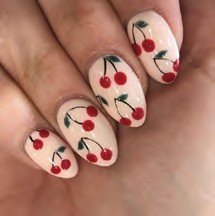
@grandnailsalon
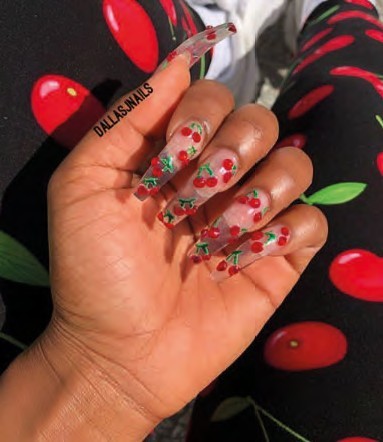
@dallasalexiaxo
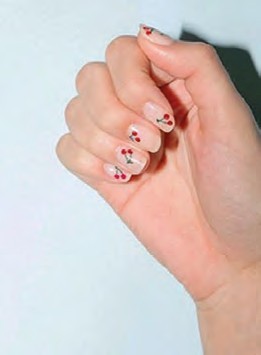
@kesangthenailartist
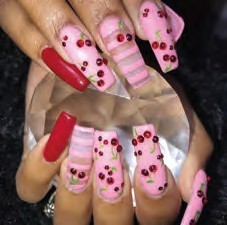
@getnailed32
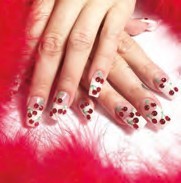
@nailsbymei
AUTUMN LEAVES
INK London educator Agnes Dullo blends classic autumnal shades with delicate nail art and subtle glitter accents in this seasonal look.
Dullo used iLac Hybrid UV/LED Gel Polish, Colour Gel Paint and Additions glitter for this design.
STEP 1 Paint the middle finger with iLac i-144 Va Va Veuve, a nude shimmer. Paint the little finger with i-121 Give Me Gold and create a gradient on the remaining three nails with a brush using i-138 Cute Camo, a dark khaki green, and i-20 Raspberry Red
STEP 2 Draw the outline of a few different leaves on the nude nail using a fine liner brush and Gel Paint in Black Knight. Cure for 30 seconds
STEP 3 Fill in the leaves with the gold, khaki and red shades used to paint the nails. Use the same fine liner brush with Black Knight to enhance the detail of the leaves
STEP 4 Use a dry brush to add some gold Lewis glitter to the tacky layer of the middle finger. Apply Megaflexi No Wipe Top Coat to all nails apart from the little finger and cure
STEP 5 Apply Megaflexi Top Coat to the little finger and sprinkle Lewis glitter into the uncured gel, tapping the excess glitter off. Cure then sweep away any more excess with a clean, dry brush.
Cherry on top
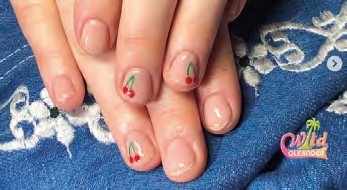
@wild_oleander
Hot on the heels of brightly coloured translucent jelly textures come cherries; set to be a popular nail art motif for autumn, if Instagram is any indicator. Techs have been drawing the super-cute fruit on pink or nude polish, or taking it 3D by topping off long, clear extensions with multiple red gems.
5 minutes with
Karen Embury, Salon System expert and celebrity and session nail artist
I started out in nails in 2012. After qualifying, I began working on lots of events and shoots, using Gellux products from when I first started training. I approached the brand to use its products as a session tech on The X Factor in 2015. It’s been my go-to brand for a long time as it has every colour and product I need.
Working at the London Olympics in 2012 is most definitely my career highlight so far, doing the athletes’ nails with patriotic flag designs.
These days, session work pretty much takes up most of my time, so I don’t really have many mobile clients, but if I do, they tend to be celebrities or red carpet jobs.
Lately, I love French manicure twists using a pop of colour, and my celebrity clients have been enjoying the jelly colours I create using Neon Gellux shades mixed with top coat. I think we’ll see something new for AW18 – dark colours with a pop of neon.
I think education is a big challenge in the nail industry at the moment, as sometimes a one-day course doesn’t even cover all the basics. Experience and education are essential, so I always try to learn new techniques and keep developing my skills wherever possible.
@karenlouisenail
Best practice
The British Association of Dermatologists (BAD) last month raised concerns after a study – Epidemic of (Meth)acrylate Allergy in the UK Requires Routine Patch Testing – found that 2.4% of people tested had an allergy to at least one type of (meth)acrylate chemical – a key ingredient in acrylic, gel and gel-polish.
But it’s not just clients who are at risk – just under two thirds (60%) developed their allergy through what was termed “recreational exposure”, in all cases due to the use of nail enhancements or to nail and/or eyelash glue. In 33% of cases occupational sensitisation was the issue, with a large number of these people having worked or currently working as nail techs.
PB’s Nail Professional of the Year 2018, Katie Barnes, shares her advice for best practice when working with products containing methacrylate, to keep both yourself and your clients safe.
How should techs prevent product from coming into contact with clients’ skin?
“Take your time when working and work with smaller, more controlled beads at the correct mix ratio. Ensure that you wait until the bead is pearly before working to prevent monomer running into the skin. It is important not to choose a brush that is excessively large; it will become overloaded with monomer, making it almost impossible to avoid skin contact. When working near the skin, your brush should always be at a 45-degree angle, and you must work towards yourself rather than the client to prevent touching the skin.”
We know that methacrylate can pass through many types of gloves. How can techs protect themselves?
“A minimum glove thickness of 8 mil (thousandths of an inch) = 0.19mm is recommended, which should conform to the EU Chemical Resistance specification EN 374-3 or higher. Gloves with an EN 374-3 rating mean the chemical resistance was met for 60 minutes or more. Gloves should be replaced after each client and you should ‘double up’ on gloves if an allergy or sensitivity is present. Nitrile gloves are recommended because latex contains a protein that can cause allergic reactions, and don’t provide nearly as good protection as nitrile.
“The tissue on which you wipe your brush and excess monomer should be positioned at the side of you, away from both tech and client. Too many techs place the tissue directly in front of them and rest their hand or arm in it as they work, constantly overexposing themselves.”
Do you think patch tests should be introduced for nail treatments, as the British Association of Dermatologists is calling for?
“Nail products and ingredients are not designed to be used on the skin, so in my opinion patch testing wouldn’t be a good idea. An allergy builds up over time from overexposure of repetitive skin contact with an allergen, starting off as irritation and redness and developing into an allergy. Patch tests could then make this worse.”